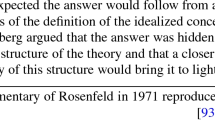Abstract
Recent advantages in experimental quantum physics call for a careful reconsideration of the measurement process in quantum mechanics. In this paper we describe the structure of the ideal measurements and their status among the repeatable measurements. Then we provide an exhaustive account of the interrelations between repeatability and the apparently weaker notions of value reproducible or first- kind measurements. We demonstrate the close link between repeatable measurements and discrete observables and show how the ensuing measurement limitations for continuous observables can be lifted in a way that is in full accordance with actual experimental practice. We present examples of almost repeatable measurements of continuous observables and some realistic models of weakly disturbing measurements.
Similar content being viewed by others
References and Footnotes
A. Aspect and Ph. Grangier, inSymposium on the Foundations of Modern Physics 1985, P. Lahti and P. Mittelstaedt, eds. (Singapore, 1985), pp. 51–72. Ph. Grangier, G. Roger, A. Aspect,Europhys. Lett 1, 173 (1986).
H. Rauch, inSymposium on the Foundations of Modern Physics 1990, P. Lahti and P. Mittelstaedt, eds. (Singapore, World Scientific, 1991), see alsoPhysica B + C 151; 1–400 (1988), and H. Rauch, pp. 347–363. inSymposium on the Foundations of Modern Physics 1993, P. Busch, P. Lahti, and P. Mittelstaedt (World Scientific, Singapore, 1993), pp. 341–360.
H. Dehmelt,Am. J. Physics 58, 17 (1989).
A. Tonomuraet al. inFoundations of Quantum Mechanics in the Light of New Technology 1989, S. Kobayashiet al. eds. (The Physics Society of Japan, Tokyo, 1990), pp. 15–24.
M. Scully, B.-G. Englert, and H. Walther,Nature (London) 351, 111 (1991).
P. Busch, P. Lahti, and P. Mittelstaedt,The Quantum Theory of Measurement (Springer, New York, 1991).
K. Kraus,States, Effects, and Operations (Springer, New York, 1983).
A. S. Holevo,Probabilistic and Statistical Aspects of Quantum Theory (North-Holland, Amsterdam, 1982).
E. B. Davis,Quantum Theory of Open Systems (Academic, New York, 1976).
G. Ludwig,Foundations of Quantum Mechanics I (Springer, New York, 1983).
E. B. Davies and J. T. Lewis,Commun. Math. Phys. 17, 239 (1970).
Such interpretations have recently been discussed by A. Elby, J. Bub, and R. Healey inFound. Phys. Lett. 6 (No. 1) (1993). See also B. van Fraassen,Quantum Mechanics: An Empiricist View (Claredon Press, 1991), S. Kochen, in Ref. 1, pp. 151–169, G. Cassinelli and P. Lahti,Found. Phys. Lett. 6, 533 (1993), and D. Dieks,Phys. Rev. A 49 (1994).
R. B. Griffths,J. Stat. Phys. 36, 219 (1984). M. Gell-Mann and J. B. Hartle, in Ref. 4, p. 321.
J. von Neumann,Mathematische Grundlagen der Quantenmechanik (Springer, Berlin, 1932).
G. Lüders,Ann. Phys. (Leipzig) 8, 322 (1951).
For an overview of these results we refer to Ref. 6, where one finds also references to important original papers.
P. Busch, M. Grabowski, and P. Lahti,Operational Quantum Physics, LNP M31 (Springer, Berlin, 1995).
P. Lahti, P. Bush, and P. Mittelstaedt,J. Math. Phys. 32, 2770 (1991).
P. Busch, G. Cassinelli, and P. Lahti,Found. Phys. 20, 757 (1990).
M. Ozawa,J. Math. Phys. 25, 79 (1984).
A. Luczak,Acta Universitatis Lodziensis (1986).
G. Cassinelli and P. Lahti,Nuovo Cimento 105, 1223 (1990);108, 45 (1993).
See, e. g., Ref. 6 or van Fraassen in Ref. 12.
For a recent critique of the projection postulate, see van Fraassen in Ref. 12
E. B. Davies,J. Funct. Anal. 6, 318 (1070).
P. Busch and P. Lahti,Found. Phys. 19, 633 (1989).
P. Busch,Int. J. Theor. Phys. 24, 63 (1985).
P. Busch and P. Lahti,Ann. Phys. (Leipzig) 47, 369 (1990).
This theorem presupposes in addition the mathematical property of complete positivity of the STV measure. As we do not use it here we refrain from giving its definition. (See, e.g., Refs. 6, 7, or 9.) It may be remarked that the physical assumption underlying this property is that the compound object-apparatus system can be viewed as an isolated system.
E. Arthurs and J. L. Kelly,Bell System Tech. J. 44, 725 (1965).
S. Stenholm,Ann. Phys. (N.Y.) 218, 233 (1992).
P. Busch and F. E. Schroeck,Found. Phys. 19, 807 (1989).
M. Bruneet al., Phys. Rev. Lett. 65, 976 (1990), H. Paul,Quantum Opt. 3, 169 (1991), M. J. Holland, D. F. Walls, and P. Zoller,Phys. Rev. Lett. 67, 1716 (1991). G. J. Milburn and M. J. Gagen,Phys. Rev. A 46, 1578 (1992).
Author information
Authors and Affiliations
Additional information
Dedicated to Peter Mittelstaedt on the occasion of his 65th birthday.
Leaving the Institute for Theoretical Physics, University of Cologne, D-50937 Cologne, Germany.
Rights and permissions
About this article
Cite this article
Busch, P., Grabowski, M. & Lahti, P.J. Repeatable measurements in quantum theory: Their role and feasibility. Found Phys 25, 1239–1266 (1995). https://doi.org/10.1007/BF02055331
Received:
Issue Date:
DOI: https://doi.org/10.1007/BF02055331



